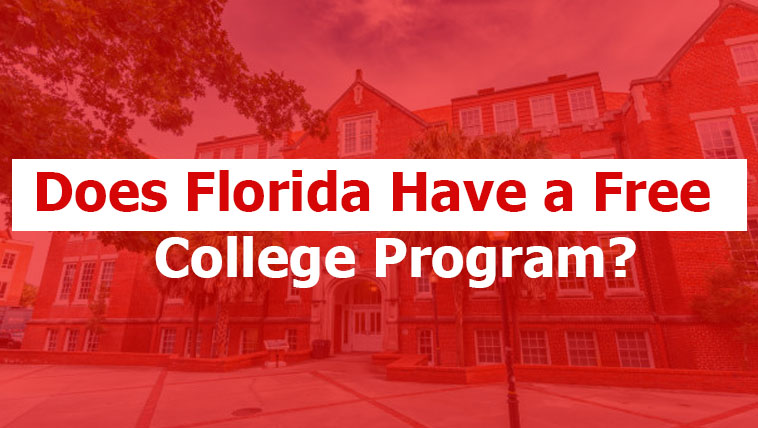Does Florida have a free college program? Yes—through Bright Futures, tuition waivers, and grants, many students can study in Florida tuition-free.
When people ask, “Does Florida have a free college program?” the quick answer is: Yes, but it’s not a universal program for everyone. Instead, Florida offers a variety of scholarships, tuition waivers, and financial aid opportunities that make college significantly more affordable for in-state students, and in some cases, nearly free.

The most notable of these is the Florida Bright Futures Scholarship Program, which can cover up to 100% of tuition and fees at public universities and colleges. Additionally, Florida has specialized tuition waivers and need-based aid that reduce or even eliminate costs for certain groups, like military veterans, foster youth, or low-income families.
To help you understand exactly how Florida’s free and affordable college options work, let’s explore the main programs and pathways available.
1. The Florida Bright Futures Scholarship Program
One of the biggest reasons people ask about free college in Florida is because of the Bright Futures Scholarship Program. Established in 1997, Bright Futures is funded by the Florida Lottery and remains one of the most generous state-run merit aid programs in the U.S. Students who meet the academic and testing requirements in high school can receive either 100% or 75% tuition coverage at public colleges and universities in Florida.
The program has two main award levels: the Florida Academic Scholars (FAS) and the Florida Medallion Scholars (FMS). FAS covers full tuition plus certain fees, while FMS covers 75% of tuition costs. Both can be applied to universities, state colleges, or technical schools within the state.
To qualify, students need a strong GPA, community service hours, and competitive ACT or SAT scores. For example, the FAS scholarship requires at least a 3.5 GPA and higher standardized test scores, while FMS requires a 3.0 GPA with slightly lower benchmarks. This makes it achievable for many hardworking students.
The impact of Bright Futures is enormous—it helps thousands of Florida students graduate debt-free every year. While it’s merit-based, it effectively creates a “free college” option for families who plan ahead.
2. Florida College System and Community Colleges
Another way Florida makes higher education affordable is through its Florida College System (FCS), which includes 28 state and community colleges. These institutions offer some of the lowest tuition rates in the nation, and many students who qualify for federal Pell Grants or state scholarships can attend virtually tuition-free.
For example, Miami Dade College, one of the largest community colleges in the country, offers associate degree programs at very affordable rates. When combined with Pell Grants, Bright Futures (which can also be used at community colleges), and need-based aid, many students pay little to nothing for tuition.
Community colleges in Florida also offer 2+2 transfer pathways, which guarantee admission to a public university for students who complete their associate degree. This makes it possible for students to complete their first two years at a very low cost—or even free—before transferring to finish a bachelor’s degree.
Because of these options, Florida’s community colleges are often the best starting point for students seeking affordable higher education.
3. Tuition Waivers for Veterans and Military Families
Florida is also recognized for its tuition waiver programs that support military families and veterans. Under programs like the Congressman C.W. “Bill” Young Veteran Tuition Waiver Program, veterans who live in Florida but aren’t official residents can still qualify for in-state tuition rates.
Additionally, the Children and Spouses of Deceased or Disabled Veterans (CSDDV) Scholarship provides free tuition to eligible dependents. This program covers 100% of tuition and fees at Florida public institutions for the spouses and children of veterans who were killed or disabled in action.
These waivers not only help reduce costs but often eliminate them completely when combined with federal GI Bill benefits. As a result, many veterans and their families can attend Florida colleges essentially for free.
4. Need-Based Aid: Florida Student Assistance Grant (FSAG)
While Bright Futures is merit-based, Florida also provides need-based financial aid through the Florida Student Assistance Grant (FSAG). This program is designed for undergraduate students who demonstrate significant financial need.
The FSAG provides grants that can be applied toward tuition and fees at state universities, community colleges, and technical schools. When paired with federal Pell Grants, it can significantly reduce out-of-pocket costs—and in some cases, eliminate tuition entirely for students from low-income households.
Because FSAG is renewable, students who continue to demonstrate financial need can keep receiving aid throughout their degree program. It’s one of the key tools Florida uses to ensure higher education is accessible to all, not just students with high GPAs or test scores.
5. Free College for Foster Youth and Homeless Students
Florida has specific tuition waivers for foster youth, former foster care students, and students experiencing homelessness. These waivers cover 100% of tuition and fees at public universities, community colleges, and technical schools in the state.
The Florida Tuition Exemption for Foster Youth ensures that students who were in the state’s foster care system after turning 13—or who were adopted from foster care after age 16—can attend college without paying tuition.
This program is crucial because it helps some of Florida’s most vulnerable populations gain access to higher education, breaking cycles of poverty and providing new opportunities for success. Combined with additional support programs like housing assistance and mentoring, foster youth have a strong chance of completing their degrees debt-free.
6. Out-of-State Student Waivers
Another unique feature of Florida’s system is its out-of-state tuition waivers. Some universities offer these waivers for students from neighboring states or for special categories like DACA recipients, allowing them to pay the much lower in-state tuition rate.
For example, the Tuition Equity Residency Waiver allows qualifying undocumented students (including Dreamers) who graduated from a Florida high school to access in-state tuition rates, which dramatically reduces their cost of college.
Though this doesn’t make college completely free, it does make it significantly more affordable for populations who would otherwise face very high out-of-state costs.
7. Online College Options in Florida
Florida also leads the way in affordable online education, with many public universities offering low-cost online degree programs. For instance, the University of Florida Online (UF Online) has been ranked one of the best and most affordable online bachelor’s programs in the country.
These online programs often come with lower tuition rates and fewer fees than traditional on-campus programs. Plus, students save money on housing, transportation, and other costs.
When combined with scholarships and grants, online education can be another pathway to earning a degree at little to no cost. This is particularly beneficial for working adults and nontraditional students who need flexibility.
8. Dual Enrollment and Early College Programs
Florida also promotes dual enrollment programs, which allow high school students to take college courses for free while still in high school. These credits count toward both their high school diploma and their future college degree.
Because tuition and fees for dual enrollment courses are waived, many students graduate high school with a year—or even two years—of college credit already completed. That means they enter college with significantly reduced costs, sometimes needing only two years to finish a bachelor’s degree.
This system effectively gives students a head start and makes college much more affordable. Families who take advantage of dual enrollment can save thousands of dollars in tuition.
9. Specialized Career and Technical Programs
Florida also supports students seeking career and technical education (CTE) through its network of state colleges and technical schools. Many of these programs are short-term, affordable, and fully covered by financial aid for eligible students.
Programs in nursing, information technology, automotive technology, and skilled trades often cost far less than a traditional four-year degree. For students using Pell Grants or Bright Futures, the programs can often be completed tuition-free.
These options expand the definition of “free college” by offering affordable training that leads directly to high-demand jobs.
10. Final Thoughts: Is College Free in Florida?
So, does Florida have a free college program? Yes, but it’s a patchwork of opportunities rather than one single program. Between Bright Futures, tuition waivers, need-based grants, dual enrollment, and community college pathways, many Florida students can graduate debt-free—or with minimal costs.
The key is knowing which programs you qualify for and applying early. Families should plan ahead by tracking GPA, standardized test scores, financial aid eligibility, and scholarship deadlines. By combining multiple funding sources, students can often create their own “free college” experience.
Ultimately, Florida stands out as one of the most affordable states for higher education, especially for residents. While not everyone automatically gets free tuition, the variety of programs ensures that nearly every student has a pathway to an affordable degree.
Also Check:
Cheapest Universities in Europe for International Students
Which College in Florida have a 100% Acceptance Rate? Here are the Top 10
Top 10 Ongoing Fully Funded U.S. Fellowships 2025 (Aug–Sep 2025 Deadlines)
